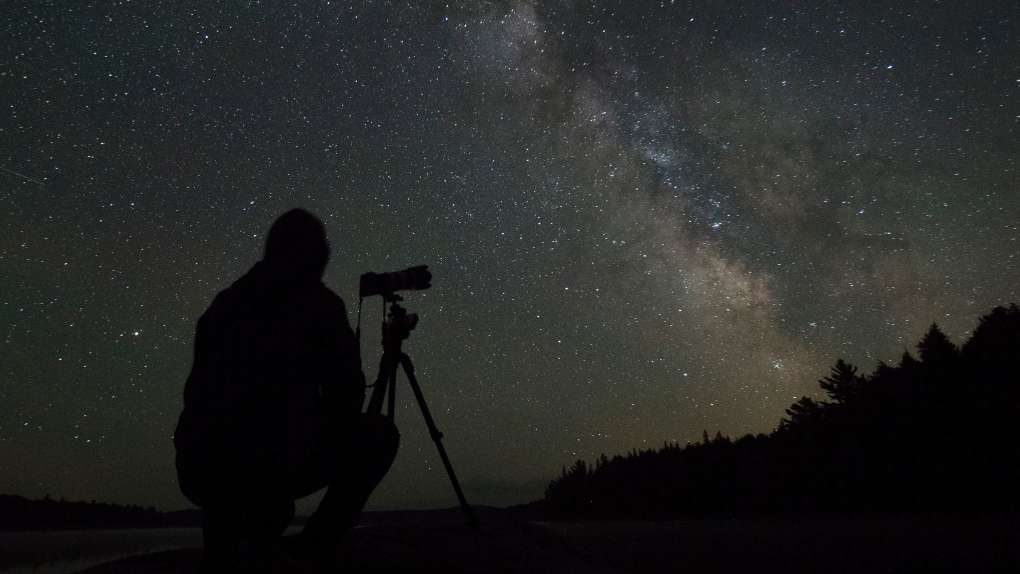5 planets align across the night sky. Here's how to see them in Ontario
 Stargazer Junbo Liang from Toronto photographs the Milky Way lighting up clear night sky over Algonquin Park Saturday June 12, 2021. With provincial re-opening people from across Ontario flocked to Ontario's marquee provincial park. THE CANADIAN PRESS/Fred Thornhill
Stargazer Junbo Liang from Toronto photographs the Milky Way lighting up clear night sky over Algonquin Park Saturday June 12, 2021. With provincial re-opening people from across Ontario flocked to Ontario's marquee provincial park. THE CANADIAN PRESS/Fred Thornhill
Five planets formed a line across the evening sky on Tuesday.
The planetary alignment will include Jupiter, Mercury, Venus, Uranus, and Mars, all visible from Earth, according to sky tracking site Starwalk.
Jupiter and Mercury will appear near the horizon, in the constellation Pisces, while Venus will be visible higher in the sky on the constellation Aries, the sky-tracking site noted.
Next, Uranus will line up nearby but a pair of binoculars may be required to get a glimpse of the planet. Finally, Mars will appear higher in the sky, near the moon, to complete the five-planet alignment.
STARGAZING TIPS
For the best chances to see the planetary alignment clearly in Ontario, astrophotographer Trevor Jones said the first thing you’ll need is clear skies.
In the Toronto area, Tuesday night is forecast to be slightly cloudy, so the planets should be visible. Check the local forecast in your area before heading out to view the alignment.
“Getting away from city light pollution is a big one too,” Jones said in an interview with CTV News Toronto last week. “You'll see much more if you're able to get away from the city lights and get somewhere a little darker.”
Jones also recommends giving your eyes some time to adjust to the darkness.
“If go straight outside, your eyes aren't going to be ready to see anything, so let your eyes adapt to the darkness for 25 minutes or so,” he said.
If possible, travelling to a dark-sky preserve – areas where light pollution has been nearly eliminated and residents can enjoy “celestial landscapes – will give viewers the best shot at a vivid show.
Canada has 13 federally-designated dark-sky preserves, areas where light pollution is kept to a minimum or eliminated completely.
PLACES TO STARGAZE IN ONTARIO
Ontario's federal dark-sky preserves include Point Pelee National Park in Essex County, Fathom Five National Marine Park and Bruce Peninsula National Park near Tobermory, Ont.
Some spots recommended for stargazing, but without official dark-sky designation, include Binbrook Conservation Area in Niagara, Ont., Torrance Barrens in Gravenhurst, Ont., and Lennox and Addington Dark Sky Viewing Area in Napanee, Ont.
Last week, a geomagnetic storm brought a rare appearance of Aurora Borealis to southern Ontario, and residents all over the province were able to take in the spectacle.
With files from CTV News' Adam Frisk.
CTVNews.ca Top Stories

Quebec nurse had to clean up after husband's death in Montreal hospital
On a night she should have been mourning, a nurse from Quebec's Laurentians region says she was forced to clean up her husband after he died at a hospital in Montreal.
Cuban government apologizes to Montreal-area family after delivering wrong body
Cuba's foreign affairs minister has apologized to a Montreal-area family after they were sent the wrong body following the death of a loved one.
What is changing about Canada's capital gains tax and how does it impact me?
The federal government's proposed change to capital gains taxation is expected to increase taxes on investments and mainly affect wealthy Canadians and businesses. Here's what you need to know about the move.
'Anything to win': Trudeau says as Poilievre defends meeting protesters
Prime Minister Justin Trudeau is accusing Conservative Leader Pierre Poilievre of welcoming 'the support of conspiracy theorists and extremists,' after the Conservative leader was photographed meeting with protesters, which his office has defended.
Northern Ont. lawyer who abandoned clients in child protection cases disbarred
A North Bay, Ont., lawyer who abandoned 15 clients – many of them child protection cases – has lost his licence to practise law.
Boeing's financial woes continue, while families of crash victims urge U.S. to prosecute the company
Boeing said Wednesday that it lost US$355 million on falling revenue in the first quarter, another sign of the crisis gripping the aircraft manufacturer as it faces increasing scrutiny over the safety of its planes and accusations of shoddy work from a growing number of whistleblowers.
Bank of Canada officials split on when to start cutting interest rates
Members of the Bank of Canada's governing council were split on how long the central bank should wait before it starts cutting interest rates when they met earlier this month.
Fair in Ontario, flurries in Labrador: Weather systems make for an erratic spring
"It's a bit of a complicated pattern; we've got a lot going on," said Jennifer Smith of the Meteorological Service of Canada in an interview with CTVNews.ca on Wednesday. "[As is] typical with weather, all of these things are related."
Police tangle with students in Texas and California as wave of campus protest against Gaza war grows
Police tangled with student demonstrators in Texas and California while new encampments sprouted Wednesday at Harvard and other colleges as school leaders sought ways to defuse a growing wave of pro-Palestinian protests.































